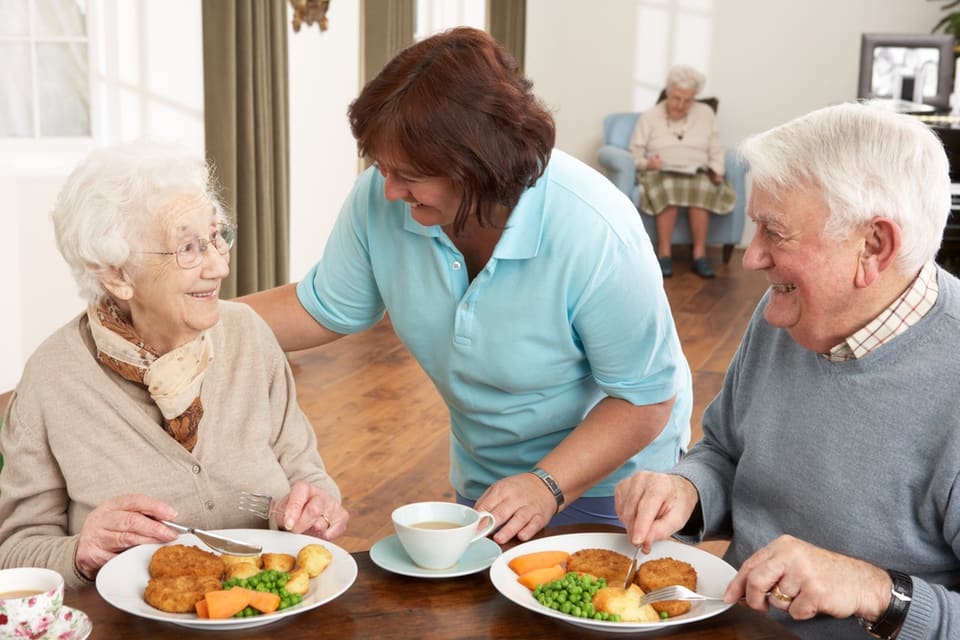Make the best senior care decision

Fresh Ways to Enjoy Senior Living Dining Services

Many senior living communities’ dining services teams are subverting expectations by revamping their menus, collecting input from residents, and working closely with dietitians and chefs to craft enjoyable and healthy selections. A trend is taking hold: Seniors want to sit down to inspiring meals that feel unique — not ones that feel like they rolled off an assembly line. When considering a community for yourself or a loved one, the proof that the community cares not just about nutrition but the dining experience will be on the plates they serve. So, be sure to schedule a tour during meal time to see and taste the food before making a decision.
Let our care assessment guide you
Our free tool provides options, advice, and next steps based on your unique situation.
“Dining is an important experience for residents at senior living communities because it’s more than just a healthy meal,” says Sara Casey, director of nutrition at Brookdale Senior Living, a brand with communities across the U.S. “Food is an aspect of their environment that residents can control. Providing multiple food choices that people enjoy eating, versus having only one option, is important in terms of their decision-making. Making dining choices gives them a sense of empowerment.”
How senior living menus balance nutrition and preferences
Casey says menus must be developed with senior-specific nutrition needs in mind: Many communities now work closely with dietitians to craft meals that are specific to residents’ unique needs. We all lose some of our taste buds as we age, and this is why Brookdale enhances their flavor with herbs and spices, Casey says. Brookdale staff do this to avoid adding extra salt to recipes, as this can sometimes be incompatible with certain nutrient-specific diets, she notes. When creating a menu for senior living dining services, a quality community knows it’s crucial to consider seniors’ specific needs and the palate of each individual. Furthermore, many communities are able to accommodate specific diets and preferences such as a carbohydrate-controlled diet or a low-sodium diet, if needed.
Communities must also value resident satisfaction when it comes to dining, Casey says. Quality communities may leave comment cards in the dining room to encourage feedback from residents on the meal they just ate, or they might host “menu chats” where residents can provide feedback and request specific menu items.
“We can even take recipe submissions from residents as well,” Casey says. “For example, if someone was really craving their grandma’s ‘famous lasagna,’ they could submit a recipe to us to review, analyze, and put into our menu system.”

Let our care assessment guide you
Our free tool provides options, advice, and next steps based on your unique situation.
What to Look for from Senior Community Dining Services
What can your loved one expect from senior dining services on a day-to-day basis? Here are some features communities offer:
Restaurant-style dining
A restaurant-style setting allows residents to socialize and enjoy the feeling of being out and about — to mimic a restaurant, residents are greeted, seated, and given a menu. Many senior living communities compete with outside restaurants in the area, and this competition can help ensure they at least strive to provide your loved one with the best dining experience possible. Senior living communities are updating their equipment to include extra features such as pizza ovens, exhibition kitchens, pastry equipment, and more, Casey says. For those moments when you or your loved one is hungry between meals or before bed, some communities choose to offer healthy, nutritious snacks to ease residents’ cravings.
Sustainable, health-conscious approaches
New ways of locating local, fresh, inspiring ingredients are also enhancing the quality of the dining experience at senior communities. Many now pay close attention to where their ingredients come from, and some go so far as to grow their own produce on site. It will be easy to see if this is happening at a community you or a loved one are considering, and, if on-site produce matters to you, ask if the community has a food garden and if you or your loved one can tour it.
Private dining rooms
More communities are adding private dining rooms to make it easier to celebrate a special event such as a birthday or anniversary. Residents may be able to reserve a community’s private dining room to celebrate with guests, and they may be able to request a custom menu. Residents are often able to invite other residents to events in these kinds of rooms free of charge, though non-residents may be required to pay for their meal. Any associated costs would vary by community. Special menus, which would feature a resident’s specific meal requests, should be created in the same way a catering service would create one: A menu is discussed and should be reviewed before plans are finalized.
Individualized options
Dietary restrictions are considered when meals at a community dining hall are planned and prepared, but this was not always the case. Now, residents who have dietary restrictions, such as those on a low-sodium diet or who are diabetic, should expect to see options that cater to their needs. Even so, be sure to inquire when choosing a community.

Talk with a Senior Living Advisor
Our advisors help 300,000 families each year find the right senior care for their loved ones.
Anytime dining
For many residents, choosing when to eat can be just as important as choosing what to eat. Flexibility when it comes to the times meals are offered is important for individuals who have established a unique routine. Also, a resident might eat smaller meals but be hungry more frequently. Reflect on your needs before selecting a community, and ask specific questions about meal times, length of meals, or whether the menu is flexible. Although many communities do not offer a full menu around the clock, some do offer grab-and-go coolers or counters, snack carts, and other venues from which to grab a quick bite. In some cases, these alternatives are open into the evening.
Professional chefs
Though less common, some communities partner with professional chefs and local, fancier restaurants to bring the best culinary experience to you or your loved one’s taste buds. Working with professional chefs allow communities to expand their menu and tailor services toward their residents’ preferences.
Satisfying their hunger
In the end, it’s all about resident satisfaction and ensuring an experience as comfortable and pleasing as possible.
“The satisfaction level with residents is important to us, because food is such a large part of life and daily interactions,” Casey says.
Senior living community dining services are an essential component in the overall experience and can be the difference between a community feeling complete, or like a true home, and feeling like a hotel or, worse, motel. It is important for a community to keep up with current trends, food trends included, as doing so often means ensuring residents feel more autonomy. A wide selection of food that is nutritious and delicious allows choice, and greater choice often translates to greater satisfaction.
The information contained in this article is for informational purposes only and is not intended to constitute medical, legal or financial advice or create a professional relationship between A Place for Mom and the reader. Always seek the advice of your health care provider, attorney or financial advisor with respect to any particular matter and do not act or refrain from acting on the basis of anything you have read on this site. Links to third-party websites are only for the convenience of the reader; A Place for Mom does not recommend or endorse the contents of the third-party sites.